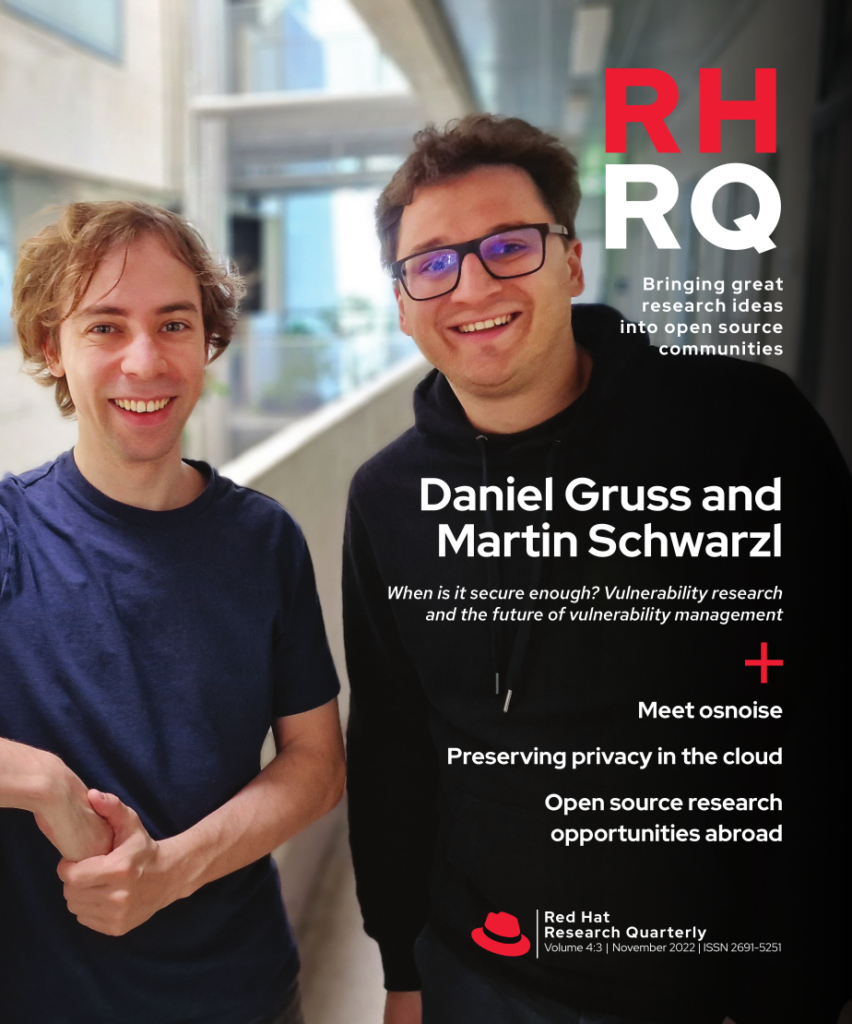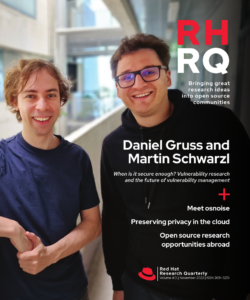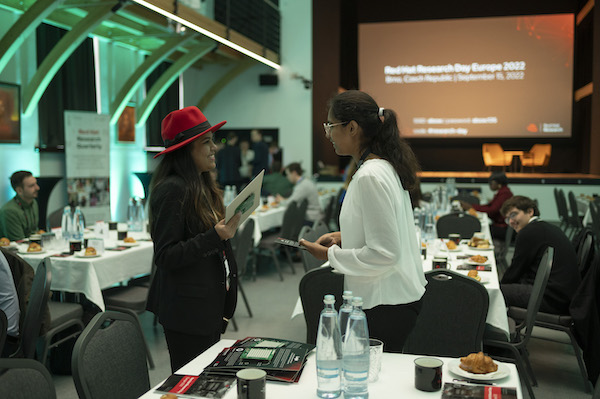
Red Hat Research Day Europe 2022 in Brno took place on September 15. The event brought together people from industry and academia, customers and partners, government institutions, and educational organizations. Attendees heard from leaders in open source innovation about their latest work and the future of open source research.
We conceived Research Day, first held at the Red Hat Summit in 2019 in Boston, as a way to promote information exchange and idea sharing among university researchers, Red Hat engineers, and open source users in the form of Red Hat partners and customers.
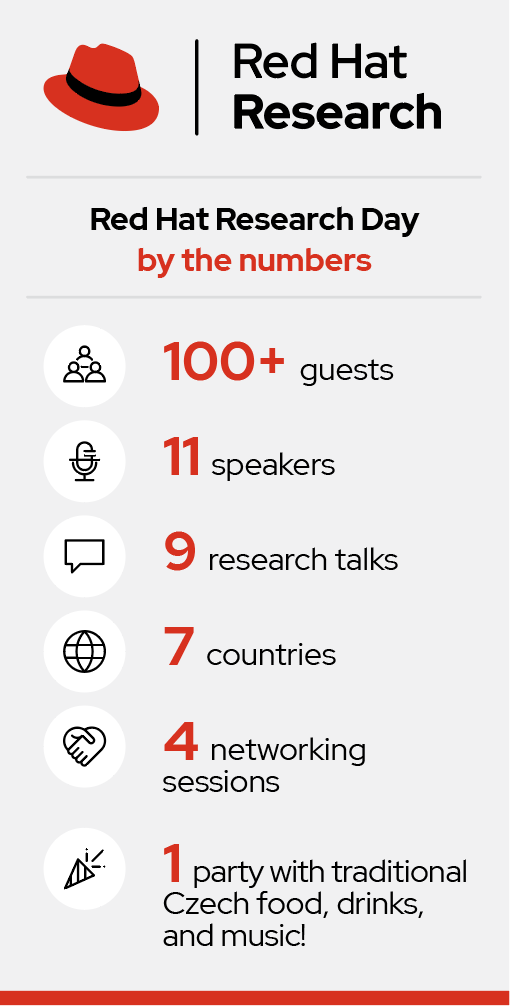
Part of the mission of Red Hat Research is to support work that is at once cutting edge and grounded in the practical needs of open source projects and the companies and institutions that use those projects every day.
We walk a fine line balancing these two contradictory concerns, and the more information we have about what motivates users of open source software, the easier it is to understand what areas are ripe for improvement versus which ones should be left alone.
Many of the projects conceived or just launching at that first event are now reaching maturity, as you can see if you visit our latest set of virtual posters. Three years later, this latest in-person event in Brno was both a welcome return to our original format and a new departure in that we did not attach it to a major Red Hat event.
Research day speakers
Speakers have made their slides available on the Research Day Europe 2022 home page. To see individual recordings of all Research Day talks, go to the Research Days 2022 playlist on YouTube.
Using static analysis for microservices
Tomáš Černý, Baylor University
Static analysis in the context of microservices has to contend with decentralization and heterogeneity across codebases—something conventional tools fail to address. This talk introduces static analysis prototypes adapted to microservice development practice to perform multiple tasks.
Analyzing the security certifications landscape: does certification help security?
Ján Jančár, Masaryk University
Security certificate documentation such as Common Criteria or FIPS 140 contains a wealth of information for vulnerability assessment and security research. However, because the documents are not standardized or machine readable, mining the documents for information is difficult. This talk proposes an automated way of gathering this information and making it more readily usable for analysis.
LEGO for 6G: a modular open access end-to-end network architecture to enable B5G/6G research
Abhimanyu Gosain, Northeastern University
This talk provides an overview of globally identified 6G candidate technology areas and suggests a roadmap for leveraging research testbeds to influence the 6G vision and accelerate the 6G research and development lifecycle. It includes the presentation of an end-to-end programmable virtualized cloud native B5G architecture built on Red Hat OpenShift.
Building a science lab with ContainerSSH
Nikos Tsipinakis, CERN; Janos Bonic, Red Hat; Sanja Bonic, Red Hat
ContainerSSH simplifies the provision of SSH in a multiuser environment, using webhooks or Kerberos to provide access independently from the underlying operating system. It is currently being tested as a pilot for the LxPlus Service at CERN, which provides access to roughly 2,000 concurrent users.
Unleashing affordable cloud resources with SpotOS
Assaf Schuster, Technion, Israel Institute of Technology
SpotOS addresses the high price of renting cloud resources by facilitating the rental of spot instances. Using optimization algorithms, predictive machine learning, efficient external storage, and stateful task management, it enables more efficient resource usage at a lower cost. This talk surveys both the challenges and the opportunities in SpotOS.
Lightweight always-on network latency monitoring with eBPF
Simon Sundberg, Karlstad University
Current software-based passive network monitoring tools often struggle to keep up with the traffic as packet rates increase. Can emerging eBPF technology enable lightweight passive network latency monitoring by implementing evolved Passive Ping (ePPing)? ePPing can run on Linux devices at speeds of over 10 Gigabits per second on a single core and has a considerable impact on the users’ quality of experience.
Programming languages to runtime execution: a continuum for service orchestration in dynamic edge/fog environments
Frédéric Le Mouël, University of Lyon, INSA Lyon
Data-heavy applications need low latency, geo-data storing and processing, and privacy and security protection, requiring new hybrid public and private edge/fog/cloud architectures. This talk presents ways to rapidly program and prototype FaaS-based distributed dataflow applications, allowing easy redeployment according to dynamic change in the environment and preventing single points of failure.
Testing the reliability of systems with unstable or low-quality network connectivity
Miroslav Bureš, Czech Technical University
This presentation introduces a specialized technique to test the processes of a system in situations when parts of these processes are affected by limited or disrupted network connectivity. The technique is explained in a practical example: a sensor network system for combat casualty care developed by the Czech Technical University in Prague in cooperation with other Czech partners.
Parametric log checking
Aleš Smrčka, Brno University of Technology
One of the main problems of log analysis is the interleaving of log messages related to different sessions, resources, and purpose-specific objects; logs are parametric. This talk describes a way to monitor a system and determine whether it is working correctly, based on the system’s log messages and the provided specification, with examples of a prototype monitoring tool applied to several different systems.
A successful return
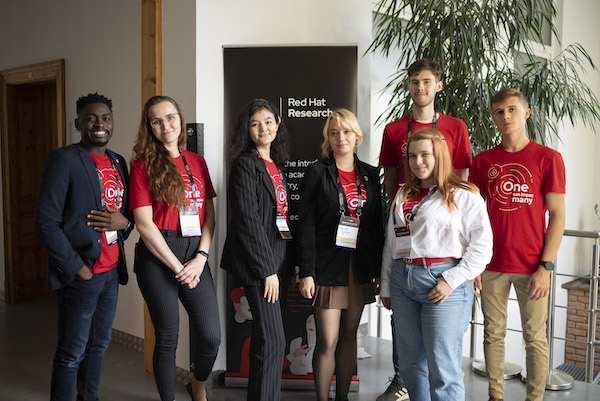
These are just some of the interns whose help with the event was invaluable.
Networking is one of the best outcomes of these in-person gatherings, and Research Day 2022 was no different. The event fostered many conversations between engineers, customers, partners, local management, academics, and researchers, and the foundations were laid for potential new projects and partnerships.
Research Day 2022 was also the grounds for the first run of the new Brno Student Ambassador Program, aimed at involving local interns as guides for international speakers. Fifteen interns took part in this initiative, and the feedback for them (and from them!) and for the program was overwhelmingly positive.
It’s been a while since Red Hat Research has been able to hold an in-person event—the last one took place in Brno in January 2020. Everyone knows what happened next: a worldwide pandemic. We were all very excited in early 2022 when our team decided to organize the next research day. Judging by the feedback received internally and externally, it was a success!
It was exhilarating to see how lively such an event can be and what value and excitement it can bring to both speakers and attendees. If we can help it, the next one will come much sooner.


